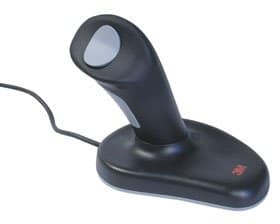 I’ve noticed strange looks when people see my mouse for the first time. Sometimes the reaction is curiosity and interest — the mouse looks a bit like a joystick, and this brings back happy memories for some of us. Other times I sense more of a “what, is this guy too good to use a normal mouse like the rest of us?” reaction.
I’ve noticed strange looks when people see my mouse for the first time. Sometimes the reaction is curiosity and interest — the mouse looks a bit like a joystick, and this brings back happy memories for some of us. Other times I sense more of a “what, is this guy too good to use a normal mouse like the rest of us?” reaction.
In either case, I think I disappoint my audience a little once I explain that it’s just a normal mouse, except that you click with your thumb instead of your fingers. This motion is much more natural for me and really helps me get through the day with less wrist pain than I get when using a normal mouse. Raising my index and middle fingers up and back from my palm repeatedly creates a lot of soreness for me over the course of a long work day. If you have wrist pain, I’d highly recommend trying out a Renaissance mouse.
That being said, I travel a fair amount, and I often am stuck using a laptop with just a touchpad and no mouse at all. I find touchpads even worse for my hands than a plain old mouse, so what to do? The answer is of course, do your best to avoid using your mouse at all. This has the benefit of relieving wrist pain, but it will also speed up your common computing tasks and impress people with your sweet keyboard skills. I’ll cover a few ways you can reduce your reliance on the mouse and improve your efficiency.
1. Pick a good editor, use it for everything, and learn all its tricks.
As a developer, you will spend the majority of your time working with text, and let’s face it, some of that time is going to be spent doing fairly repetitive tasks. Learn an editor that can help you eliminate repetition and avoid reaching for the mouse. Maybe you’re an Emacs fan, or perhaps you prefer VIM or TextMate. I happen to love Sublime using the Vintage (VI) mode, and I can’t ever see myself giving up the multiple cursors — they’re so much fun. When choosing an editor, be sure to pick one which allows you to perform every common task using command keys. It’s especially important that you can quickly navigate between and within files without having to reach for the mouse.
2. The browser is not your friend. Or is it?
Web pages are often my downfall when it comes to avoiding the mouse. Many are designed only for pointer input, and this makes it tough to get around with the keyboard. Do yourself a favor, though, and learn the keyboard shortcuts for your browser. I happen to use Chrome mostly, and learning Chrome’s keyboard shortcuts will certainly save you a little mousing. Some basics are opening (Command/Ctrl-T), closing (Command/Ctrl-W), and switching between tabs (Ctrl-Tab). A tap on the space bar will scroll a page down, or you can use Alt and the up or down arrow to page up and down. Command/Ctrl-D will bookmark a page for you. And of course Command + left and right will move backwards and forwards in your browsing history. Ctrl-l is one of my favorites – it will move focus to the address bar and highlight the current text so that you can enter a new URL or search term. While generally less useful, you can also tab through links on a page and hit enter to follow one. Putting this together, you can use Ctrl-l to jump to the address bar, or Ctrl-t to open a new tab, type in a search term, hit tab and enter to open the first result.
Some of the websites you use most will support keyboard shortcuts for common operations. I use Gmail all the time, and their shortcuts are pretty thorough. It can be tough to think of keyboard shortcuts when using web apps, but put together a list of the sites you use the most and search for shortcut lists, or loudly demand shortcut support if you find that there isn’t much available.
3. Make good use of fuzzy finders, and learn your OS windowing shortcuts.
Assuming that you’ve learned to drive your editor via the keyboard, probably the best remaining way to reduce mousing is to learn to work with your window manager via the keyboard. The first thing is to make use of fuzzy finding to launch applications, web searches, etc. For Mac users, I’d of course recommend Alfred to allow you to never go mousing through that dock again. I’d also recommend reading through the OS X keyboard shortcuts to at least see what’s there. They aren’t all winners, but the shortcuts for switching between windows and workspaces will certainly be worth your time, as will the common finder shortcuts. There are even keyboard shortcuts to move the mouse around, although these are less usable with a laptop keyboard layout.
4. Track your habits.
I’d recommend spending a day or two trying your best to be aware of every time you reach for the mouse. Make a log of your most common usage patterns, and search for ways to perform these same actions from the keyboard. I’m not advocating that you never touch a mouse again, but if you do suffer hand/wrist pain, it will be well worth your time finding keyboard actions to replace your most common mousing habits. Every reach for that mouse or touchpad is slowing you down, and adding to those sore hands at the end of the day!
